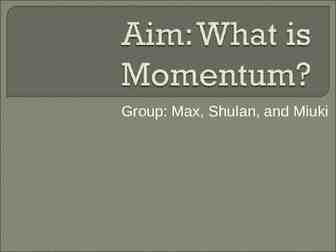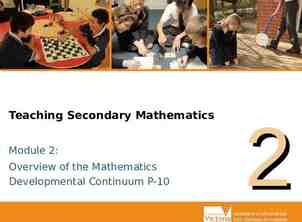Chapter 2: Intro to Relational Model Database System Concepts, 6th Ed.
22 Slides845.00 KB
Chapter 2: Intro to Relational Model Database System Concepts, 6th Ed. Silberschatz, Korth and Sudarshan See www.db-book.com for conditions on re-use
Example of a Relation attributes (or columns) tuples (or rows) Database System Concepts - 6th Edition 2.2 Silberschatz, Korth and Sudarshan
Attribute Types The set of allowed values for each attribute is called the domain of the attribute Attribute values are (normally) required to be atomic; that is, indivisible The special value null is a member of every domain. Indicated that the value is “unknown” The null value causes complications in the definition of many operations Database System Concepts - 6th Edition 2.3 Silberschatz, Korth and Sudarshan
Relation Schema and Instance A1, A2, , An are attributes R (A1, A2, , An ) is a relation schema Example: instructor (ID, name, dept name, salary) Formally, given sets D1, D2, . Dn a relation r is a subset of D1 x D2 x x Dn Thus, a relation is a set of n-tuples (a1, a2, , an) where each ai Di The current values (relation instance) of a relation are specified by a table An element t of r is a tuple, represented by a row in a table Database System Concepts - 6th Edition 2.4 Silberschatz, Korth and Sudarshan
Relations are Unordered Order of tuples is irrelevant (tuples may be stored in an arbitrary order) Example: instructor relation with unordered tuples Database System Concepts - 6th Edition 2.5 Silberschatz, Korth and Sudarshan
Keys Let K R K is a superkey of R if values for K are sufficient to identify a unique tuple of each possible relation r(R) Example: {ID} and {ID,name} are both superkeys of instructor. Superkey K is a candidate key if K is minimal Example: {ID} is a candidate key for Instructor One of the candidate keys is selected to be the primary key. which one? Foreign key constraint: Value in one relation must appear in another Referencing relation Referenced relation Example – dept name in instructor is a foreign key from instructor referencing department Database System Concepts - 6th Edition 2.6 Silberschatz, Korth and Sudarshan
Schema Diagram for University Database Database System Concepts - 6th Edition 2.7 Silberschatz, Korth and Sudarshan
Relational Query Languages Procedural vs .non-procedural, or declarative “Pure” languages: Relational algebra Tuple relational calculus Domain relational calculus The above 3 pure languages are equivalent in computing power We will concentrate in this chapter on relational algebra Not turning-machine equivalent consists of 6 basic operations Database System Concepts - 6th Edition 2.8 Silberschatz, Korth and Sudarshan
Select Operation – selection of rows (tuples) Relation r A B D 5 (r) Database System Concepts - 6th Edition 2.9 Silberschatz, Korth and Sudarshan
Project Operation – selection of columns (Attributes) Relation r: A,C (r) Database System Concepts - 6th Edition 2.10 Silberschatz, Korth and Sudarshan
Union of two relations Relations r, s: r s: Database System Concepts - 6th Edition 2.11 Silberschatz, Korth and Sudarshan
Set difference of two relations Relations r, s: r – s: Database System Concepts - 6th Edition 2.12 Silberschatz, Korth and Sudarshan
Set intersection of two relations Relation r, s: r s Note: r s r – (r – s) Database System Concepts - 6th Edition 2.13 Silberschatz, Korth and Sudarshan
joining two relations -- Cartesian-product Relations r, s: r x s: Database System Concepts - 6th Edition 2.14 Silberschatz, Korth and Sudarshan
Cartesian-product – naming issue Relations r, s: r x s: Database System Concepts - 6th Edition B r.B s.B 2.15 Silberschatz, Korth and Sudarshan
Renaming a Table Allows us to refer to a relation, (say E) by more than one name. x (E) returns the expression E under the name X Relations r r x s (r) Database System Concepts - 6th Edition r.A r.B s.A s.B α α β β 1 1 2 2 α β α β 1 2 1 2 2.16 Silberschatz, Korth and Sudarshan
Composition of Operations Can build expressions using multiple operations Example: A C (r x s) rxs A C (r x s) Database System Concepts - 6th Edition 2.17 Silberschatz, Korth and Sudarshan
Joining two relations – Natural Join Let r and s be relations on schemas R and S respectively. Then, the “natural join” of relations R and S is a relation on schema R S obtained as follows: Consider each pair of tuples tr from r and ts from s. If tr and ts have the same value on each of the attributes in R S, add a tuple t to the result, where t has the same value as tr on r t has the same value as ts on s Database System Concepts - 6th Edition 2.18 Silberschatz, Korth and Sudarshan
Natural Join Example Relations r, s: Natural Join r s A, r.B, C, r.D, E ( r.B s.B r.D s.D (r x s))) Database System Concepts - 6th Edition 2.19 Silberschatz, Korth and Sudarshan
Notes about Relational Languages Each Query input is a table (or set of tables) Each query output is a table. All data in the output table appears in one of the input tables Relational Algebra is not Turning complete Can we compute: SUM AVG MAX MIN Database System Concepts - 6th Edition 2.20 Silberschatz, Korth and Sudarshan
Summary of Relational Algebra Operators Symbol (Name) σ (Selection) Example of Use σ salary 85000 (instructor) Return rows of the input relation that satisfy the predicate. Π (Projection) Π ID, salary (instructor) Output specified attributes from all rows of the input relation. Remove duplicate tuples from the output. x (Cartesian Product) instructor x department Output pairs of rows from the two input relations that have the same value on all attributes that have the same name. (Union) Π name (instructor) Π name (student) Output the union of tuples from the two input relations. (Set Difference) Π name (instructor) -- Π name (student) Output the set difference of tuples from the two input relations. (Natural Join) instructor department Output pairs of rows from the two input relations that have the same value on all attributes that have the same name. Database System Concepts - 6th Edition 2.21 Silberschatz, Korth and Sudarshan
End of Chapter 2 Database System Concepts, 6th Ed. Silberschatz, Korth and Sudarshan See www.db-book.com for conditions on re-use



























